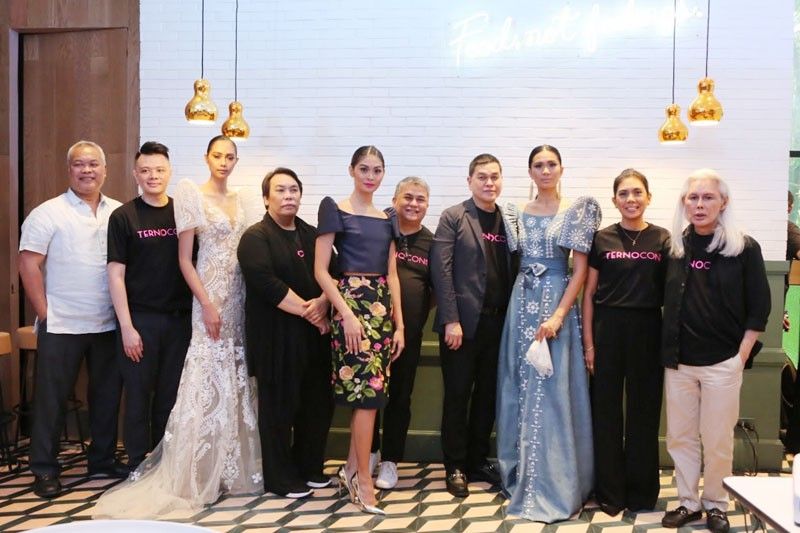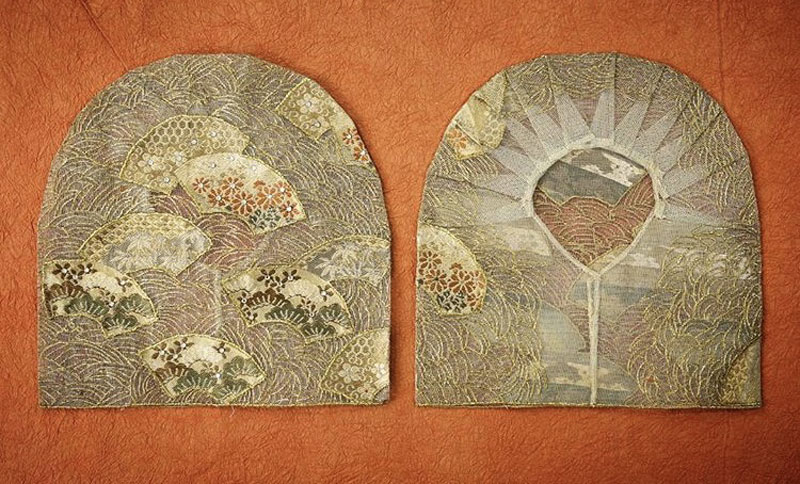Making the Terno fashionable again


Imagine we’re at a formal event, and dozens of beautiful Filipinas are clad in ternos — some with intricate embroidery, some incorporating local weaves, all as colorful as butterflies flitting about with their arched bell sleeves. Maybe one young lady has a cola, or train, that she holds up daintily with one hand as she climbs the stairs. When she reaches the top, she lets it go and it flutters to the ground with a dramatic, elegant swish.
This isn’t a scene out of a movie or a dream: it will be reality on Nov. 11, when Ternocon 2018 will be held at the Cultural Center of the Philippines’ (CCP) Main Theater.
Ternocon is a collaboration between Bench and the CCP. It started in 2004, when Suyen Corporation chairman and CEO Ben Chan mounted a terno fashion competition at the Metropolitan Museum. “It was also a tribute to my dear friend, the late, great designer Joe Salazar, who was devoted to the terno and never tired of designing it,” Chan says.
In 2015 Bench published the book Fashionable Filipinas: An Evolution of the Philippine National Dress in Photographs 1860-1960, curated and written by Ternocon project director Gino Gonzales and Mark Lewis Higgins, which Chan said made him understand “the difficult journey of this beautiful garment and the women who wore it.”
“We don’t see a lot of millennials wearing the terno nowadays, but I hope this advocacy will change that,” Chan says. “In Japan we see young girls proudly wearing the kimono. Same in Korea, where you see them wearing the han bok; same in China for the cheongsam and India for the sari. We have to wear the terno or it’s bound to disappear.”
According to Gonzales, publishing a book and creating awareness for the terno wasn’t enough, so they came up with a project called Ternocon in 2016. “We went to the NCR, Luzon, Visayas and Mindanao doing three-day workshops, and brought with us a school: equipment, machines, books — all paid for by Suyen Corp. Our local counterparts selected designers and cultural workers who were all interested in the terno.”
 A photo from the Ternocon 2018 Instagram account shows vintage butterfly sleeves from the atelier of Salvacion Lim Higgins, combining appliqués and metallic embroidery on translucent cañamazo. The Japanese motif shows her fascination with Orientalia. Photo by JO ANN BITAGCOL
A photo from the Ternocon 2018 Instagram account shows vintage butterfly sleeves from the atelier of Salvacion Lim Higgins, combining appliqués and metallic embroidery on translucent cañamazo. The Japanese motif shows her fascination with Orientalia. Photo by JO ANN BITAGCOLEach participant learned about the history of the dress and its phases, and built patterns of a particular dress. At the end of the three-day workshop, they created an actual garment.
“I thought that there was one more hurdle that needed to be overcome: a problem with aesthetics,” says Gonzales. “So we decided to hold a competition that had two categories: one is for the traje Balintawak — the country version of the terno that was short, for fiestas, and came with an alampay (shawl) or a tapis (rectangular cloth cover-up); and the second is for the formal evening terno, which is normally long and wouldn’t have the alampay or panuelo (square cloth folded as a collar) anymore.”
The First Terno Designer Was A Woman
Gonzales, a multi-awarded stage designer and scenographer whose mentor was National Artist Salvador “Badong” Bernal, told me how the terno evolved from the traje de mestiza, or Maria Clara gown commonly associated with Jose Rizal’s tragic heroine: “The butterfly sleeves as we know it only started in the 1920s,” he explains. “It was a woman designer, Pacita Longos, who flattened the sleeves during the art deco period, so everyone followed the trend.”
Though not widely known, Longos was one of the first designers of the terno. “When we say ‘terno’ we only know Ramon Valera, but she preceded him,” notes Gonzales. “People are saying maybe she even mentored him, because if you look at the carnival queens before, they all wore ternos, and most of the time it was Pacita who made them. She was really an innovative designer: she’d put art-deco details, make it ombre — very skilled.”
From the 45 participants of the “Fashioning the Terno” workshops, the 30 finalists for Ternocon 2018 were selected based on their performance during the workshops.
 Daphne Oseña-Paez hosts the Ternocon 2018 press conference at Bench Café with (from left) Chris Millado, Inno Sotto, Gino Gonzales and Ben Chan.
Daphne Oseña-Paez hosts the Ternocon 2018 press conference at Bench Café with (from left) Chris Millado, Inno Sotto, Gino Gonzales and Ben Chan.“We thought of inviting three mentors from the different regions,” Gonzales says. “It was very important that the mentors came from the regions, because we wanted the participants to look up to the people who came from their areas and who spoke their language and understood them.”
For the Luzon mentor they chose JC Buendia from Batangas, a designer known for his clean lines and impeccable tailoring. During his mentoring session Buendia talked about restraint in design and the use of the terno sleeve form, bringing with him Joe Salazar’s wooden sleeve mold and a beaded terno crafted by the iconic designer.
For the Visayas mentor they selected Cary Santiago from Cebu, known for his cultural couture and intricate detailing. “Cary showed them how to measure bodies and bodices, and taught them how to make corsets,” notes Gonzales.
For the Mindanao mentor they picked Len Cabili from Iligan, known for successfully incorporating indigenous motifs into contemporary wear in her line Filip+Inna. Cabili showed them Mindanao weaves and how they could be integrated into terno designs.
“In order to tie in all the mentoring, we decided that we needed one chief mentor, and we only had one person in mind to do it — someone they would all listen to and respect,” Gonzales says, “and that was Inno Sotto.”
Sotto and the regional mentors advised all the contestants last May, when Ternocon flew them in for a convention at the CCP. “They looked at extant examples of vintage ternos, and examined how they were constructed,” Gonzales says.
Sotto brought bolts of fabric with him: “I had to familiarize them first with the feel, the use of fabrics,” the designer says. “In the Philippines, even if we have so many schools now, we don’t have museums, or archives, or costume institutes, for that matter. So it’s so difficult for designers who study fashion to familiarize themselves with fabrics, to see how they were used at a certain point in time. So the first day I brought rolls of real pure silk gazar — as opposed to what they call gazar here — real satin, chiffon, organza, as opposed to what is available here. And I said, ‘It’s not for you to get frustrated that you can’t find this, it’s only for you to know the actual use and feel of the fabric. Joe Salazar had a gift for handling fabrics. Salvacion Higgins had a gift for that, Christian Espiritu, Ben Farrales, Ernest Santiago — all of them.”
For Sotto, what’s most important is understanding the designer’s point of view. “Some have really interesting things to say; some… the millennials there will kill me for this, but there is a limitation. They’re not too concerned about the things of the past. They’re more interested in the things of today, people they see on social media — what they do, what they wear, as opposed to what they used to wear. And I’m not talking about the people way, way back; I’m talking about the people from the ’50s, the ’60s, and the ’70s. Because if one were to get interested in that, you’d see that people were really wearing the lifestyle then, and I tell them, ‘If you’re interested in fashion, you have to open your mind to getting interested in other things. Look at book covers, movie posters, graphics in magazines; you have to see how photography has changed so much.”
Both Chan and Sotto agree that appreciation for the terno is dying, and Ternocon aims to save it. “There is reason to wear it in formal affairs; you don’t have to wear a western gown,” Sotto says. “I think it’s important to wear the Philippine dress. Japanese women, Chinese women, Indian women do it with so much pride.”
A Different Kind Of Fashion Spectacle
CCP vice president and artistic director Chris Millado promises that Ternocon 2018 on Nov. 11 will be a different kind of fashion spectacle. “We will showcase 90 ternos — 60 from the regions and 30 from the mentors,” he says. “To make the show even more spectacular we’re bringing in the Philippine Philharmonic Orchestra, the traditional performing group Subli from Batangas, a folkloric dance company and the Philippine Madrigal Singers. Director Dexter Santos is fresh from the huge success of Ang Huling El Bimbo and we’re going to have surprises in staging. It’s going to be a different relationship between the audience and the performance; they’re going to manipulate the space so that they don’t have that same traditional experience of watching in the Main Theater.”
Gonzales, who was in charge of manipulating the space, spilled some of his stage secrets to the STAR: “I realized that it’s really difficult to see the clothes from the gallery, from the audience, so we’ve decided to put both the audience and the models onstage — that’s why we only have an audience of 400. The aesthetic will be Pinoy, but we’re not hiding things the way we normally do, so we’re exposing the cables, the fly lines, you’ll see people operate the systems. And we’ll have a few set changes to signify the three different segments of the show. Dexter, who’s directing it, will open the show with Subli from Batangas, a group of dancers who’ll wear the terno and dance the Subli as a form of prayer. So it’s going to be a culture-packed event, not just clothes, but dances also that use the terno, plus the orchestra, and Pinoy food for the cocktails.”
After the winners are announced at Ternocon 2018, it seems the only thing left to do is set up a terno museum or Institute of Philippine National Dress.
“It’s a dream of mine,” is the only thing Ben Chan will say.
* * *
Ternocon 2018 will be held at the Cultural Center of the Philippines’ Main Theater on Nov. 11 at 6 p.m. The dress code is a cocktail terno for the women and a barong Tagalog for the men. For more information, call the CCP at 832-3674 or email ccp.ced2014@gmail.com; call Bench at 777-7888 or email adandpromo@benchtm.com.















